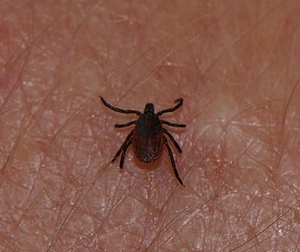According to a recent field study conducted by the Centers for Disease Control and various universities, Washingtonians are among those at highest risk in the US for contracting Lyme disease.

For those who have unfortunately gone through its enduring symptoms, that’s not exactly welcome news. We asked Dr. Marc Siegel, a specialist in internal medicine and infectious diseases at George Washington University, what everyone should know about the disease and how to avoid it.
How do people contract Lyme disease?
It’s contracted through the bite of infected black-legged ticks, also known as deer ticks, which are prevalent in the Northeast, Mid-Atlantic, and North Central United States. These ticks often attach to the human body in hard-to-see places such as the groin and armpit.
Where does the name Lyme disease come from, anyway?
The disease was first diagnosed in Lyme, Connecticut.
Who is most at risk?
The disease doesn’t discriminate: Men, women, and children are all susceptible. Anyone who is exposed to infected ticks is at risk.
Why is Washington at high risk while other regions, like the South, are virtually Lyme-disease-free?
The black-legged ticks that carry Lyme disease are found mostly in the Northeast region (from New York State all the way down to DC), Wisconsin, and Northern California. Other areas of the United States may have other species of ticks, which don’t carry the disease. For instance, the South is host to dog ticks and lone star ticks, neither of which carry Lyme disease.
What are the symptoms of Lyme disease?
There are a number of symptoms to look out for. In the beginning stages of the disease, many people notice a “bull’s-eye” lesion (called erythema migrans) with a pale center and redness radiating outward. As the disease spreads, symptoms may include red, circular patches all over the body, swollen joints, and/or neurological conditions such as meningitis (an infection of the lining of the brain) or encephalitis (an infection of the brain tissue).
How can Lyme disease be prevented?
It’s important to be on the lookout for ticks, although this can be difficult. The immature black-legged ticks that are responsible for most human infections are tiny–sometimes only as big as the head of a pencil–and their bites are usually painless. The best way to avoid tick bites is to be aware of your surroundings. Black-legged ticks, which feed off of rodents and deer, tend to cling to the undersides of blades of grass, so if you’re tramping through the woods on a hike or camping in the middle of a field, be especially vigilant and cover exposed skin by wearing long pants and sleeves. You can spray on insect repellant, too. However, bug spray is more effective at preventing mosquito bites than tick bites.
Can this disease be treated effectively?
In most cases, oral antibiotics (including doxycycline and amoxicillin) are effective at treating the disease. For more advanced neurological symptoms, intravenous medications are often prescribed.
So the next time you’re heading off into the wilds of Washington for camping, hiking, or other outdoor adventures, make sure to spray down, cover up, and keep your eyes peeled for those sneaky ticks.

















